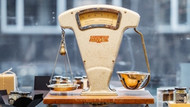How Much Does a Pool Table Weigh? Learn the Slate vs. Wood Difference
Posted by Home Billiards on 28th Aug 2023
Choosing the wrong pool table weight is like choosing the wrong shade for your wall colour. It might seem trivial, but it can make or break your experience. If you’re looking to buy a pool table soon, this page will help ensure you select one that’s the right weight and balances your needs for quality, portability and cost.
Selecting the proper weight is important because pool tables that are too light might be flimsy and unstable. One that’s too heavy might damage your floors or might not fit into the pool room you’ve renovated.
Your TL;DR Key Takeaways
Choosing the right pool table weight is crucial for a satisfying gaming experience, as it affects stability, quality, and portability. Here's what you'll discover in this article.
- Why Weight Matters
- Impacts stability, quality, and portability.
- Weight Range
- Pool tables typically weigh 500 to 2,500 pounds.
- Factors Affecting Weight
- Size: Larger tables are heavier.
- Thickness: Thicker surfaces add weight.
- Materials: Different cabinet materials contribute to weight.
- Accessories: Items like storage solutions and bumper cushions increase weight.
- Material Options
- Slate: Denser and more durable.
- Wood: Lighter alternative.
- Installation and Placement
- Understanding weight is crucial for safe setup and quality assessment.
- Maintenance
- Ensure floors can support the table.
- Use proper techniques for moving the table.
- Buying Tips
- Consider your need for durability versus portability when choosing a pool table.
How much does a pool table weigh?
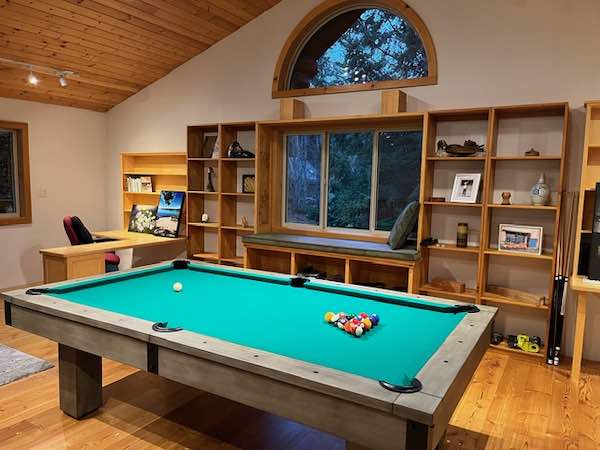
Depending on several factors, a pool table can weigh approximately 500 to 2,500 pounds.
For example, a 6-foot slate pool table weighs 500 pounds, whereas a 12-foot slate table weighs 2,500 pounds - drop pockets and bumper cushions included.
Conversely, a 6-foot MDF pool table made of wood fibres pressed together with a resin starts at a featherlight weight of 160 pounds, whereas a 12-foot MDF billiards table weighs up to 700 pounds.
We’ll explore other variables influencing your pool table weight in the section below.
But how much does a pool table weigh exactly? Here's the tl;dr version:
Pool Table Weight Chart
| Slate Bed Pool Table | Approx. Weight |
| 6 Foot Table | 500 lbs (227kg) |
| 7 Foot Table | 700 lbs (317kg) |
| 8 Foot Table | 1,000 lbs (454kg) |
| 9 Foot Table | 1,300 lbs (590kg) |
| 10 Foot Table | 1,500 lbs (680kg) |
| 12 Foot Table | 2,500 lbs (1134kg) |
| Wood Bed Pool Table | Approx. Weight |
| 6 Foot Table | 180 lbs (82kg) |
| 7 Foot Table | 275 lbs (125kg) |
| 8 Foot Table | 320 lbs (145kg) |
| 9 Foot Table | 450 lbs (204kg) |
| 10 Foot Table | 600 lbs (272kg) |
What makes a pool table heavy
A pool table’s weight depends on several factors, from table size and playing surface to surrounding construction and pool table accessories.
Beyond the size of a table, your choice of pool table materials, particularly the playing surface, will have the most significance on the end weight of your pool table.
Slate vs. wood
Slate is a rock-like pool-table material made of clay, quartz, and sand. This composition gives slate pool tables a smooth, albeit dense, feel.
Side note: These traits significantly enhance playability because you can play harder and longer without damage like warping.
Pro tip: If a slate pool table seems too heavy to transport, most manufacturers have three-piece slate bed models that make it easier to move. Due to the seams created between each piece of slate, these table configurations must be installed correctly or it can impact your play.
By contrast, wooden pool tables are typically made of medium-density fiberboard (MDF), and since wood is lighter than stone, a wooden pool table will be lighter than a slate table.
A standard 8-foot slate pool table typically weighs between 700 and 1,000 pounds.
Cheaper pool tables made from MDF lead to lower pool table weights. But heavier slate bed tables are more resistant to impacts and, consequently, more durable. So a 1,000-pound 8-foot pool table made from slate will last you longer than a 320-pound wood table or a 280-pound MDF table.
You’re essentially trading durability and quality for portability. While slate is considered a better pool table material, the overall quality of a pool table is determined by a combination of factors, including materials, construction, and craftsmanship.
Size of table
Once again, we see that size matters! A smaller table weighs less than a table with a larger playing surface. The tradeoff is whether you want to play on a larger, more challenging surface.
The average weight of a small pool table is 500 pounds, whereas a 12-foot slate table weighs 2,500 pounds. Conversely, a 12-foot tournament-size table from wood will weigh 600 pounds.
That said, there’s another pool table size that matters when determining a pool table’s weight:
Pool table thickness adds to the overall weight as well.
60-70% of the total weight of a pool table comes from the material used for the bed. Therefore, the thickness of the slate or hardwood will influence how much a pool table weighs.
Here’s what that entails:
- Tournament pool tables: Most in this category have slate beds up to 2 inches.
- Most home and bar pool tables feature 3-piece beds totalling 1 inch thick.
- The smallest beds: These are one-piece slate beds with a 0.5-0.75-inch thickness.
Like playing surface materials, thickness will impact the quality and durability of your table.
Cabinet materials
After sliding past the pool table bed, let’s focus on cabinet materials, which account for 30-40% of your pool table’s weight.
The cabinet parts include legs and a frame, which can be made from wood or other materials like glass (yes, glass).
Side note: Heavier tables require enough sturdy legs and surrounding materials to support them. As do wider pool tables. Make sure your table is engineered with the correct number of legs.
For example, smaller tables with an MDF bed may need only four legs, whereas a 12-foot snooker table may need eight. The top table rails also need a strong material like hardwood to withstand normal play.
What does that mean in terms of overall pool table weight?
Like the bedding, lighter materials decrease your pool table's weight and durability. Similarly, choosing the appropriate cabinet material can impact your pool table’s aesthetics and structural integrity.
Pool table felt
The weight added by the pool table felt is determined by the table's size and brand of felt.
| Brand/Type | Weight (gsm) | Table Sizes Available | Material Composition |
|---|---|---|---|
| Simonis 760 | 355 gsm | 7', 8', 9' | 30% nylon / 70% wool (your original) |
| Simonis 860 | 410 gsm | 8', 9' | 10% nylon / 90% wool |
| Hainsworth Club Cloth | 435 gsm | 6', 7', 8', 9' | 95% Merino wool / 5% nylon |
| Hainsworth Smart | 460 gsm | 7' (UK), 9′ | 95% Merino wool / 5% nylon |
| Championship Invitational | 21 oz | 7′, 8′, 9′, 10′ sets | ~75% wool / 25% nylon Medium-speed napped cloth |
| Championship Tour Edition 3030 | 24 oz | 7′, 8′, 9′, 10′ sets | ~70% wool / 30% nylon Nap-free, smooth, fast playing surface |
Here's a look at how Simonis 960 cloth stacks up by various table sizes.
| Table Size | Typical Felt Area (sq. ft) | Approx. Felt Weight Simonis 860 (410 gsm) |
|---|---|---|
| 6ft | 35–40 | ~0.54–0.62 kg (1.2–1.4 lbs) |
| 7ft | 40–45 | ~0.66–0.73 kg (1.5–1.6 lbs) |
| 8ft | 45–50 | ~0.74–0.82 kg (1.6–1.8 lbs) |
| 9ft | 50–55 | ~0.82–0.91 kg (1.8–2.0 lbs) |
While it may seem negligible compared to the rest of the table, all of these add up to a heavy piece of furniture.
Table accessories
Pool table accessories will also increase the weight of your pool table because of the added material. However, high-quality pool table accessories will enhance your pool table’s functionality and make your experience more enjoyable.
One such accessory is the Perfect Drawer, a convenient storage solution you can attach beneath your pool table to store billiard accessories. A ball return feature or rubber bumper cushions will increase your table’s weight by 100-150 pounds.
So, while you gain convenience and functionality, you should ensure your floors can sustain the added weight.
Will I have to reinforce my floors for a slate pool table?
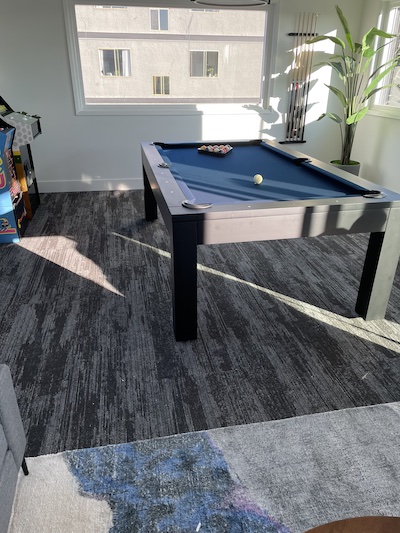
Warning: If there are any doubts about whether your floors can handle the weight of your pool table, you must talk to a professional before installing your table.
The answer to this question is most likely no. But let’s review the variables behind this decision:
Floor structure
Most residential subfloors can support the average weight of a standard-size pool table without any problems. However, wooden floor planks might not support heavier pool tables.
If you have concerns about your floor or if it’s an older building with potential structural issues, you should consult a professional to assess your floor’s integrity.
You can read more about the best flooring for your pool table.
Table size
While larger tables tend to be heavier, the number of legs influences weight distribution.
A 12-foot tournament table weighing 2,500 pounds and resting on eight legs implies 312 pounds per leg. But if you were to pick the same billiards table with six legs, the weight per leg would be approximately 417 pounds – which may be too much for some floors. In this case, you might consider reinforcing the area directly beneath your table.
Pro tip: The weight distribution might only be across some legs, depending on the design of your pool table. This may impact how you reinforce your floors, so it’s worth checking.
Location
When choosing the right pool table for your needs, consider its location. If you plan to place this new addition on an upper storey, reinforcing the floors might be a good idea even for the smallest pool tables. Basements or ground-level areas with concrete floors generally have more load-bearing capacity and require no (or less) reinforcement.
Pro tip: If you hire professional help to handle the installation process, they’ll ensure the table is set up securely. And they’ll also assess whether you need any floor reinforcement.
We have a guide on where to put a pool table in your house.
How do I protect my floors from the weight of a pool table
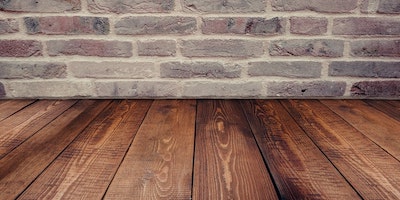
Pool tables are indeed heavy and may damage your floors. Here’s what you can do to keep your floors safe.
- Use floor mats or rugs: This will minimize the risk of indentations or scratches. Remember to use non-slip carpets or rugs to prevent any movement or shifting of the table during gameplay.
- Attach felt pads or glides to your pool table’s legs: These provide a protective barrier between the legs and the floor, reducing the chance of scratches or damage.
- Regular maintenance: Keep your pool table clean and well-maintained to avoid debris or dirt trapped underneath the legs. Also, regularly inspect your floor and the table’s contact points to find and fix potential issues quickly.
How do you move a pool table?
The best way to move a pool table is to call a team of professionals who specialize in moving pool tables. They will know how to disassemble the slate bedding and carry the parts with ease and safety.
That said, here are the basic steps:
- Gather the necessary equipment: You will need a power drill, socket wrench, screwdrivers, moving blankets, straps, and a furniture dolly.
- Remove the pockets and rails: Use your power drill or a socket wrench. Put all these parts in labelled bags to avoid mixing them.
- Detach the slate: Lift and separate each slate from the frame. You’ll likely need multiple people to help here so you won’t injure yourself or damage the pool table.
- Disassemble the legs and frame: Follow the manufacturer’s instructions and keep track of all the screws and parts.
- Protect the components: Wrap each pool table part in moving blankets or bubble wrap, and use packing tape to secure them.
- Move the components: Use a furniture dolly to transport the heavier elements like the slate and frame.
- Transport and reassemble: Carry the components to the new location, but keep them flat to avoid damage. When you get to the new room, reassemble your pool table in reverse order.
Why is it important to know the weight of the pool table?
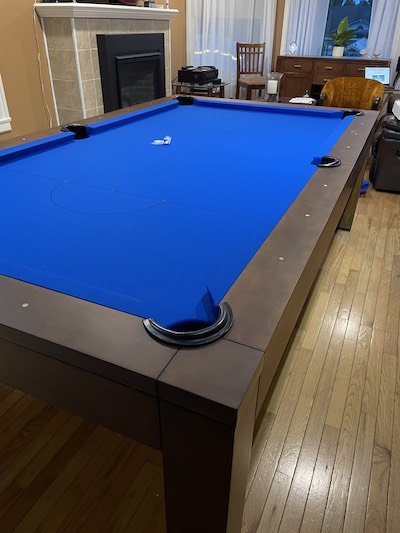
Knowing the weight of your new pool table helps you assess whether you need a pool table moving and installation service or whether you can do it yourself after you’ve made a purchase.
Knowing the overall weight will also inform you whether you need a rug or felt pads under the table and whether you can place it in an upstairs room. It’ll tell you whether the structural integrity of your floors is high enough to sustain a pool table or whether you need to reinforce your floors.
The weight of a pool table will also help you assess the quality of the table. If it’s too light or too heavy based on the criteria we shared above, you need to consider why.
Frequently Asked Questions
How Do I Properly Level a Pool Table?
Level a pool table by placing a machinist’s level on the playing surface, adjusting each leg or shim until the bubble is centered. Recheck all sides and corners. Confirm the level both horizontally and diagonally. Fine-tune using playing tests like rolling balls across the table to ensure even movement.
What are the benefits of portable or folding pool tables compared to traditional heavy models?
The main benefits of portable or folding pool tables compared to traditional heavy models include easy storage, transportability, and space efficiency. Folding tables can be set up quickly in smaller rooms and stored when not in use, while heavy tables require permanent placement and professional installation.
How does the pool table’s material affect its long-term stability and required maintenance?
The material of a pool table affects long-term stability and maintenance by determining its durability, resistance to warping, and surface wear. Slate tables offer superior stability and low maintenance, while MDF or wood tables are more prone to warping and need frequent adjustments or replacements.
Is there a warranty or guarantee that covers issues related to pool table weight or damage from improper support?
Most pool table warranties exclude damage from improper support or flooring collapse due to excessive weight. Some premium manufacturers offer limited coverage if the table is installed by certified professionals. Always review warranty terms to confirm coverage for structural issues caused by poor installation or support.
Picking the right pool table
After reading this article, you’re better equipped to choose the right table.
A heavier pool table made of slate is more durable, higher quality, and fun to play on. However, wooden or MDF tables are easier to carry (and cheaper to purchase).
If you’re not yet sure what pool table would fit your needs, read our pool table buyers’ guide for a more in-depth breakdown of all the factors you should consider.

